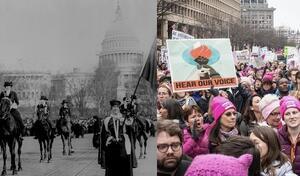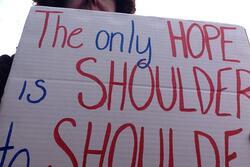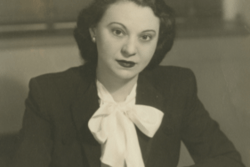Marching with Sadie
Sadie Loewith would have marched this weekend, joining a million other women around the world as they took to the streets to demand a more equal society.
I know this because Sadie did march in 1920, joining the multitudes of other women in the streets of Washington D.C. who were fighting for the ratification of the 19th amendment (you know, the one that made it possible for women to vote, paved the way for legalization of birth control, expanded the economic and educational opportunities for women, and made every part of our current society possible).
Once the amendment was passed, Sadie didn’t throw out her clever and incisive poster (which would have been handstitched at the time) and settle back into a routine of quiet domesticity. No, Sadie had gotten a taste for revolution and used the skills she learned during the fight for suffrage to shape the rest of her life.
As her son, Howard, remarked on Sadie’s career as a political activist:
“From 1920 on, she served in every election—local, state, and national—as an active party worker. She organized, and served as president of, a string of Republican women’s groups ... She also served for six years as an active and innovative member of the Bridgeport Board of Education. Under her tenure, and as a result of her backing, new buildings were erected and a single salary schedule for men and women was implemented. In addition, she helped establish a higher minimum wage for teachers.”
Sadie’s story is what democracy looks like. Don’t get me wrong, democracy looks like millions of women coming together to stand up for their rights and to hold our country accountable for the ways that it has undervalued and mistreated women. But, democracy also looks like this: one individual using her new-found political power and sense of activism to create change for others. The world of Bridgeport, Connecticut (Sadie’s home base) looked incredibly different for women and educators by the time Sadie passed away, on January 26th, 1956, and that difference was one Sadie created through her decision to stay involved and to keep working for change. She was an inspiring precursor to the millions of women who are working for change today, by running for office, sharing their experiences, and giving voices to marginalized groups.
Sadie’s story is a reminder that when women march, we aren’t marching alone. Rather, these routes have been trod and navigated by women for centuries. Sadie was fighting for the most basic civil right: the right to have a say in who makes decisions for her.
And, hopefully, just as the 19th amendment was just the beginning for Sadie, the women’s march is just the beginning (or middle if you are a veteran activist like Heather Booth, Alicia Garza, and Gloria Steinem) of our involvement in shaping political discourse at the local, state, and national level.
As Sadie Loewith experienced after the passing of the 19th amendment, there is no going back when it comes to political involvement, and this past year has been a crash course on how to march, agitate for change, call our senators, show up for people of color, and run for office ourselves.
At the beginning of a year that promises to be a wild ride, socially and politically, buckle up and remember Sadie!







